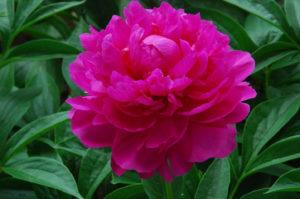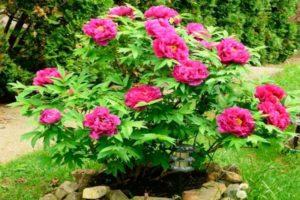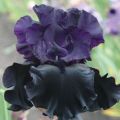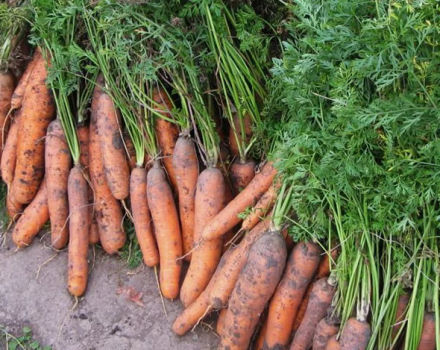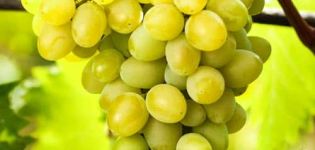Description of the 12 best varieties of coral peonies, planting and care rules
The color scheme of different peonies is varied. Peonies with a coral tint have become very popular. Gardeners owe the appearance of peonies with an unusual shade to the scientists L. Cousins, S. Wissing, A. Sanders. Now peonies with a coral hue have spread throughout the world, and are popular with gardeners. The name "coral" means the play of stone, it is a mixture of bright pink, light orange, with fawn, shades in different combinations.
Description and features
Peonies are perennial plants of shrub, semi-shrub, herbaceous species, necessarily with several dense stems no higher than a meter. Achievements of scientists in breeding give summer residents more than 5 thousand species of peonies.
The peculiarity of all varieties is that they must be planted in the ground from the beginning of autumn, no later than mid-September. By this time, the buds of the plant have time to fully form. All types of peonies take root well in the Middle Lane, tolerate winter frosts, summer showers and droughts. It is important to plant the bushes correctly and care for them correctly.
How do they look
Their root system is well developed to support a powerful bush. Foliage - trifoliate or pinnately-divided, alternately arranged along the stem. The color of the leaves is distinguished by a dark green, dark purple, gray color. In autumn, the foliage turns yellow, turns red. The buds vary in diameter from 17 to 25 centimeters. The inflorescences are multi-leaved, in some varieties they are star-shaped. Fading away, give a box with rounded seeds.
Note! Gardeners appreciate all varieties of peonies for their easy care, different shapes, and a peculiar aroma.
What varieties are there
The flowering period of peonies is determined by the formation of large buds, all varieties of plants bloom at about the same time, and then an amazing aroma spreads throughout the summer cottage village. Gardeners note that each variety of peonies has its own aroma, but, in general, it is a single scent that will be remembered for a lifetime.
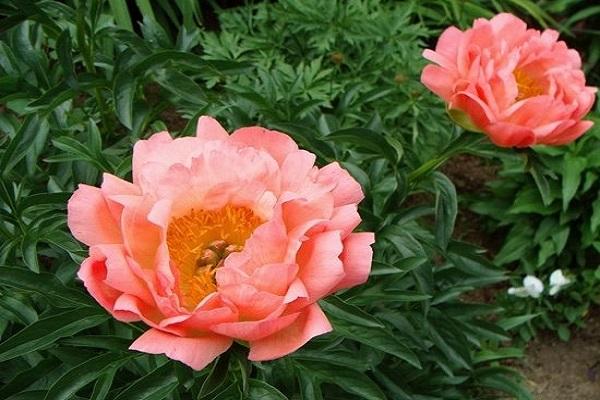
Pink
Most of all, gardeners value Pink peonies. It is an intraspecific variety bred by American selectors. Its inflorescences are anemic, leaves are terry. The flowers are light, coral pink. A fully opened bud reaches an average diameter of up to 12 centimeters. The bush grows up to 70 centimeters.
The main value of this species is that it has strong stems that do not break in the wind and when cut into bouquets. The color of the leaves is light green. It is a mid-late variety with a weak aroma.
Hawaiian
Hawaiian peonies have only positive reviews from gardeners.It belongs to the universally herbaceous, blooms 1 time, but abundantly. It is an intraspecific variety of Pink Hawaiian, its bush reaches a meter in height. The opened bud is 20 centimeters in diameter. The petals are semi-double, the main color is milky-flowered, apricot tone. In the center, the inflorescence is decorated with stamens of a bright creamy shade. Hawaiian peonies smell like fresh hay. Gardeners highly appreciate this variety, noting its good resistance to winter cold, early flowering.
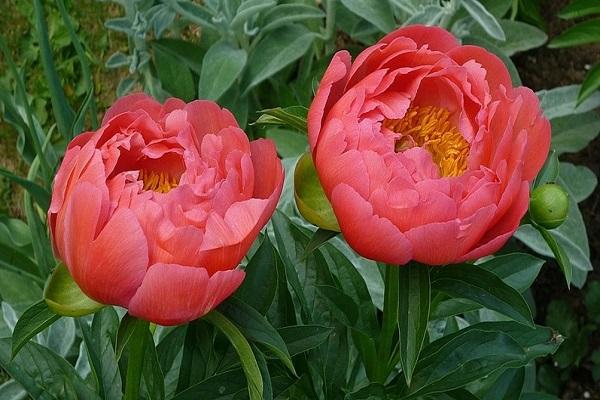
Beach
The characteristic of the Beach variety is soft coral tones. The variety is also milk-flowered. The height of the bush is at least 90 centimeters. The leaves along the entire stem are dark green in color. The opened flower reaches 17 centimeters.
This variety is distinguished by a flower in the form of a water lotus. Blooms early, blooms for a long time. The flower petals are semi-double, decorated with a core of bright yellow flowers. It is appreciated by gardeners for its frost resistance, drought resistance.
Fey
The Fairy peony variety is a hybrid of several species. Bred by US breeders in 1972. It is a low shrub plant that grows only up to 75 centimeters. Flowers are distinguished by their rounded shape, semi-double petals. The main color of Fay is pink with a pronounced coral tone. To the center of the flower are petals of a darker color. The opened bud grows to only 16 centimeters in diameter.
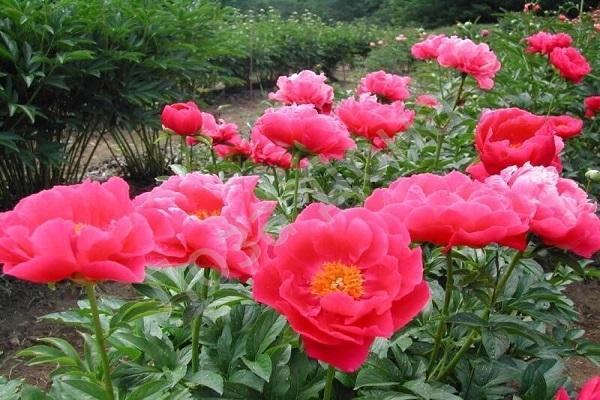
Fairy has a delicate aroma that gives the bouquet a real elegance. Leaves are light green, carved, similar to decorative. Fairies begin to bloom very early, which attracts all gardeners.
Coral Sunset
Novice growers love the Coral Sunset variety. The plant is perennial, the stems are high, straight, compact bush, up to 90 centimeters high. The flower is in the form of a bowl, the petals are semi-double. The diameter of the flowers is up to 20 centimeters. The color of the flower is unusual - peach, interspersed with pink and red tones. Fading, the petals turn yellow.
All Sunset shades are in perfect harmony with the bright green foliage. The leaves retain their color all season and look decorative. Flowers have a pleasant aroma. This type of peony is a participant in many exhibitions, competitions, winner of various awards.
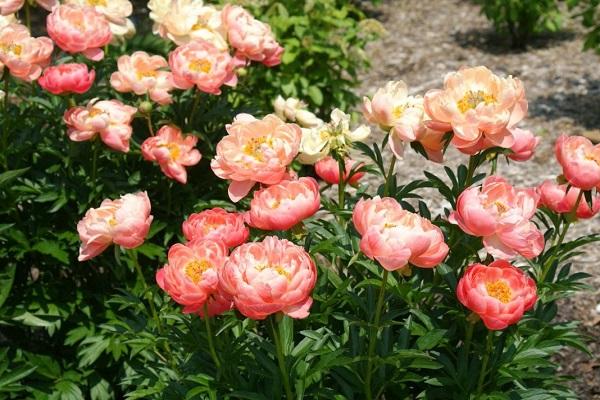
Suprem
The gardeners were pleased with the appearance of the Supreme peony. It is a rare hybrid variety that is distinguished by its showiness. A shrub variety with powerful stems with leaves of a rich green color.
The height of the bush reaches 90 centimeters.
Supreme flowers - bowl-shaped, semi-double petals of interesting salmon color give a coral pink inflorescence. Ripening, the petals brighten to a pearlescent beige shade. The diameter of the flowers is up to 20 centimeters. The flowering period is medium early.
Coral Charm
Coral Charm herbaceous bush decorates the cottage. Its difference is in the original color of the flowers. When it starts to bloom, the flower turns dark pink. Dissolving, the petals change their shade to a light coral, a light border appears along their edge. Flowering ends with another transformation: the petals acquire a yellow color. All the time of flowering, the petals are semi-double, large.
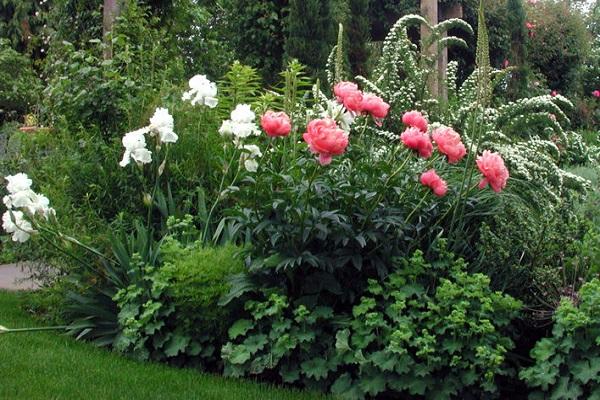
The size of the blossoming flower reaches 20 centimeters in diameter. The structure of the bud is interesting: it consists of 8 rows of petals. This makes the flower incredibly lush. The foliage of a dark green tone and the stems of a reddish hue add luxury to the bouquet. At the same time, strong stems do not break in bouquets. The bush grows at least a meter. Peony Coral Charm - early flowering cultivar. Its beauty has been pleasing gardeners since the beginning of summer.
N Gold
Peony N Gold admires, it has an interesting color and large flowers, decorated with fluffy stamens of a delicate coral shade. This variety blooms early - from March. The inflorescences are in the form of a bowl, in full disclosure, reach 20 centimeters. They are distinguished by the richness of the sweet aroma.The peony blooms for a long time, densely, the inflorescences stay in their structure for about two weeks. The height of the bush is up to 90 centimeters. There are many leaves, they are distinguished by narrow lobes, dark green color.
Magic
The variety was recently bred, striking the eyes with colorful flowers. Its flowers are three-row, with semi-double petals of bright color. Their circumference reaches 15 centimeters, the middle is decorated with bright yellow stamens. A compact and low bush grows up to 70 centimeters. The stems are strong, stand upright, covered with leaves of a pale green tone. It is an early flowering variety - the first buds appear in April.
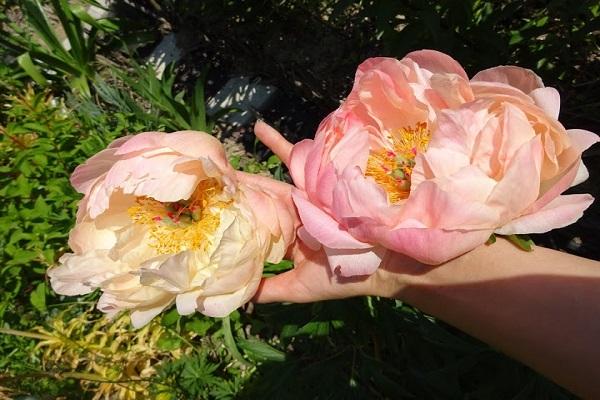
Cora Louise
The amazing variety Cora Louise is an intersectional hybrid, is a bush that grows up to a meter, its stems are strong, densely covered with decorative leaves of a dark green hue. The color of the leaves remains until the autumn cold. The flowers are large, up to 25 centimeters in diameter, the petals are semi-double.
The tone of the flower is interesting - it varies from white-pink, white-cream, to pale lilac. At the base, the petals are painted with a lavender-purple hue, which gives an expressive color center of the flower. The bright yellow stamens add to the charm. Their aroma is light, sweetish. Cora Louise is a medium flowering cultivar.
Topeka Coral
A hybrid shrub that grows up to 70 centimeters, its stems are strong, covered with large green foliage. Inflorescences of a beautiful spherical shape, with terry petals of coral-pink colors. The maximum color saturation of the flower is achieved before full bloom, then brightens, takes on a peach hue. Flowering hybrid variety - early and medium. The fragrance has a mild musky flavor. Topeka Coral flowers are large, perfectly folded, completely filled with petals.
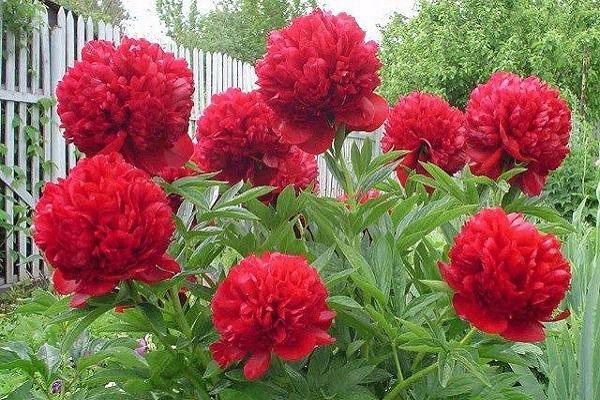
Cora Louis
The flowering of the hybrid variety Cora Luis, similar to mountain peonies, is fascinating. Blooms early - from April, with large white-pink flowers, with purple and burgundy stains at the base of the petals. The middle of the flower is decorated with bright yellow stamens. The opened flower reaches a diameter of 25 centimeters. The bush blooms for 2-4 weeks, reaches a height of 90 centimeters. The openwork foliage retains its rich green color until the autumn cold, then the color becomes crimson.
Quinn
A herbaceous cultivar with a closed root system grows up to 90 centimeters.
The flower is filled with double petals of an interesting multicolored color - outside they are white-cream, inside - yellow, in the middle - pale, pinkish. The buds are located on top of strong stems and bloom early.
Know gardeners! The variety of varieties allows you to choose any one according to your taste, but each variety requires its own care.
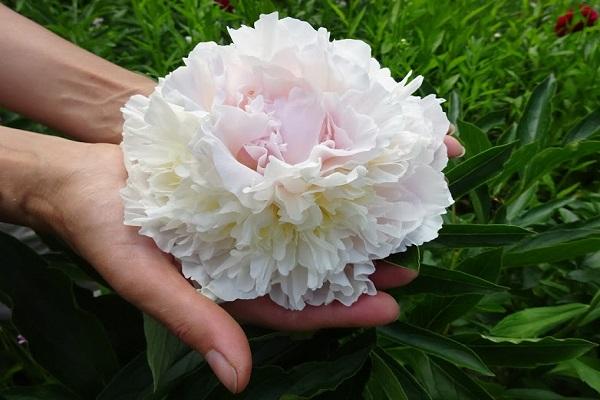
How to plant
Coral peony varieties are planted in shaded areas where there is protection from direct sunlight. However, in the shade, the stems of peonies tend to stretch, weaken, fall under the weight of blossoming flowers.
Planting rules are the same as for all hybrid peonies. When planting, you need to pay attention to the distance between the shoots in order to leave them room for development in breadth. In this case, in the 2nd year, the plants will begin to bloom, by the 4th year they will become a decorative decoration of the suburban area. Without a transplant, the bushes grow up to 10 years, then the rhizome must be divided and planted.
Seat selection
It is necessary to plant young shoots in a shady place, with access to sunlight, with protection from the winds. It is best to do this around tall shrubs, under spreading trees. When planting close to home, you must observe the distance required for the growth and development of roots. This space is not less than 1.5-2 meters.

Need to know! The growth and development of peonies will depend on the correct choice of planting site.
Land preparation
Peonies require fertile soil. To improve it, nutrition is introduced. Peonies thrive on loamy soils.If the soil consists of heavy clay, its composition must be improved by adding humus and peat. The soil should be well-drained and loose.
If the soil is heavy in the country, the owner builds a special flower bed, partially replacing the earth cover. To do this, dig a hole up to half a meter deep, remove unsuitable soil, pour a composition of sand, turf, organic fertilizers into the hole in a ratio of 1: 2: 2. Young peony bushes are planted in such pits.
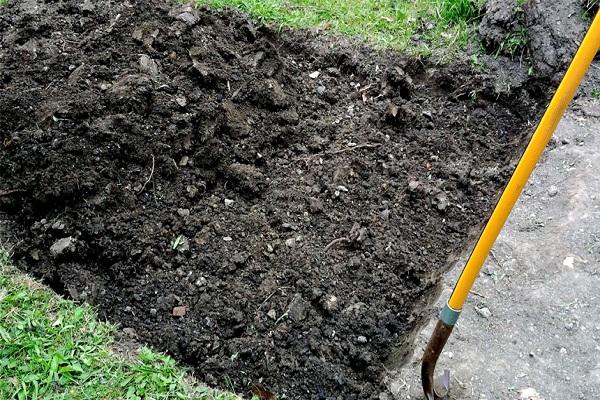
Fertilizer
Fertilizers are applied directly with the planting of young shoots. A mixture of ash, potassium sulfate and superphosphate in equal amounts is poured into the hole, with a total volume of no more than ½ bucket. Then the planted plant is watered with a weak solution of potassium permanganate. Fertilizers must be applied under the bushes of adult plants. To do this, use the purchased complexes in the amount of 80 grams per season.
Peonies are fed three times per season. The first time - early in the spring, fertilizers are poured into a groove previously dug around the bushes. The second fertilization is carried out during the formation of buds, the third time - 2 weeks after the end of flowering. A single dose of fertilization is 1 tablespoon per 10 liters of water.
How to plant
New shoots of peonies are planted and planted from late August to mid-October. At this time, the air is cooled to +12 degrees - the most suitable temperature for the formation of suction roots, their growth is important for good survival of young shoots. Bushes are planted in the spring, but in this case, the seedlings can hardly stand the summer heat, do not give flowers.
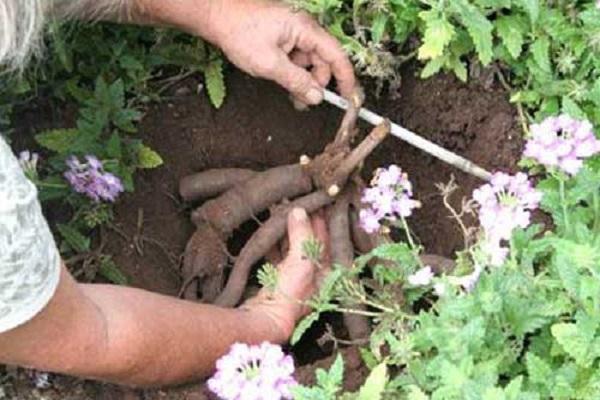
Planting is carried out in this order:
- first, pits are prepared no more than 60 centimeters in depth, with a distance between them of at least 1 meter;
- if the soil is very wet, the pits are buried a little more in order to pour the drainage mixture, gravel onto the bottom;
- the root is positioned so that the first buds are 5 centimeters below the edge of the fossa. The deep or high position of the buds does not allow the shrub to bloom in the first season;
- the root part is carefully covered with soil, excluding the formation of voids, this is important for the nutrition of the roots;
- the soil is trampled, uncompacted earth is poured around the bush to a height of up to 5 centimeters.
The earthen edging of the bush retains water when watering. Under young peonies, it is necessary to constantly maintain humidity, while preventing overflow of water.
Irrigation
It is important to keep the soil moist, especially in spring, during the formation of buds, their flowering. It is necessary to properly irrigate the land under the peonies in autumn, when the buds of future flowers are laid. Watering is carried out at the rate of 2 buckets of water per bush, so that it irrigates the soil sufficiently in depth, to the very roots. In dry summer, adult peonies need watering once a week.
Attention! Young bushes need to be watered rarely, but abundantly. The main thing is that the soil does not dry out.
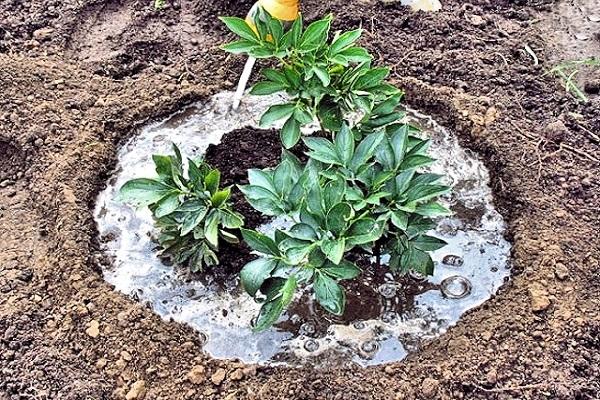
Mulching
The soil under the bushes of peonies during the dormant period must be mulched. For this, dried grass, straw, sawdust are used. The mixture is poured into the ground in the autumn flower bed when the peonies finish flowering. In the spring, the mulch layer must be removed to make room for the growth of new shoots.

How and when to transplant
In the first year, it is important for the plant to form a strong root system, so the young buds are cut off. The bush matures, and after 4 years of active flowering, it can be dug up and divided. The division is carried out from mid-August to the end of September. The separated shoot should have 2-3 well-formed buds and a rhizome of at least 15 centimeters. Before planting, the separated shoots are disinfected with a solution of saturated manganese, the cut site is treated with charcoal.
Now shoots can be planted in a new location. They must be watered abundantly, for the winter the earth must be mulched with compost. In the spring, the mulch layer is removed, the released soil is gently loosened.
